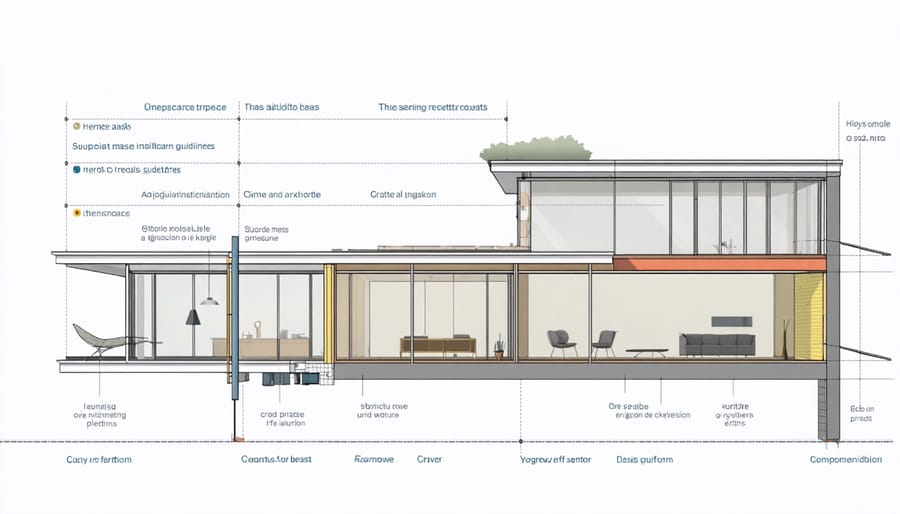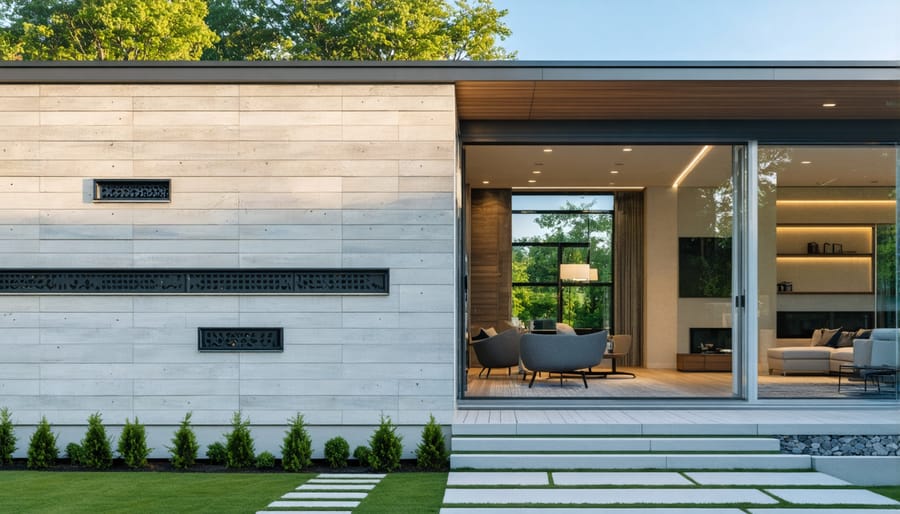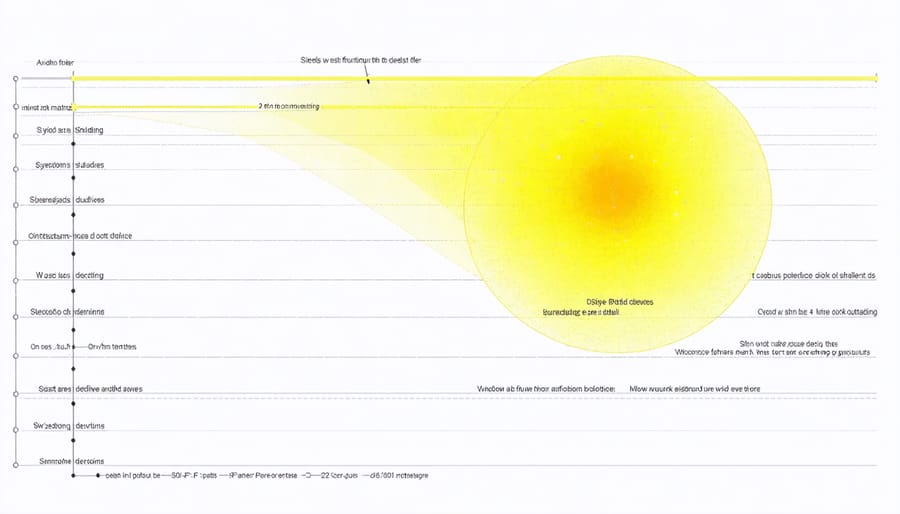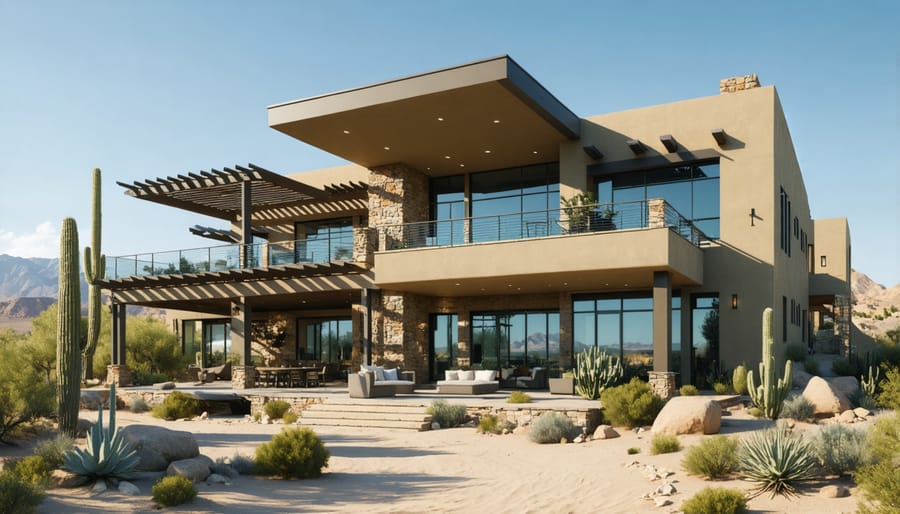Transform your home into an energy-efficient sanctuary with passive solar design – a cornerstone of modern home architecture that harnesses nature’s power to heat, cool, and illuminate spaces. From the sun-drenched homes of Arizona’s desert landscapes to the snow-capped mountain retreats of Colorado, passive solar design has revolutionized how we approach sustainable living.
Picture expansive south-facing windows that flood rooms with winter warmth, strategically placed thermal mass walls that store heat like natural batteries, and thoughtfully designed overhangs that provide shade during scorching summer months while welcoming low-angle winter sunlight. These aren’t just architectural features – they’re intelligent design solutions that can slash energy bills by up to 80% while creating naturally comfortable living spaces.
In this exploration of passive solar excellence, we’ll journey through remarkable real-world examples that showcase how homeowners and architects are mastering the art of working with nature rather than against it. From modest urban renovations to groundbreaking eco-homes, these case studies prove that sustainable design doesn’t mean sacrificing comfort or style. Whether you’re planning a new build or looking to retrofit your existing home, these proven passive solar strategies will illuminate the path to a more sustainable future.

The Sunspace Wonder: Modern Greenhouse Living Rooms
South-Facing Glass Walls Done Right
When it comes to maximizing solar gain, south-facing glass walls are a game-changer in passive solar design. The key is strategic implementation that captures winter sun while preventing summer overheating. To get it right, position your glass walls within 30 degrees of true south, which allows for optimal sunlight collection during winter months when the sun sits lower in the sky.
The size of your glass walls matters significantly. A good rule of thumb is to aim for glass area that’s about 7-12% of your total floor space. This ratio provides enough solar gain without creating excessive heat loss at night or during cloudy weather. For the best results, use double or triple-pane windows with low-E coatings, which help retain heat while reducing UV damage to your interiors.
Don’t forget about overhangs! Properly sized roof overhangs or awnings above your glass walls are crucial. They should be designed to block high-angle summer sun while allowing low-angle winter sun to penetrate fully. A typical overhang should extend about 2-2.5 feet for every 8 feet of glass height in most U.S. latitudes.
Consider incorporating thermal mass materials like concrete floors or stone walls near your glass surfaces. These elements absorb excess heat during the day and release it slowly at night, helping maintain comfortable indoor temperatures. Remember to keep your glass clean and unobstructed to maximize solar gain potential throughout the year.
Thermal Mass Integration in Living Spaces
Integrating thermal mass into your living spaces is like adding a natural temperature regulator to your home. The key is strategically placing heat-absorbing materials where they can capture and release solar energy throughout the day. Start with your floors – dark-colored tile, concrete, or natural stone in areas that receive direct sunlight work wonders for heat storage. These materials slowly release warmth in the evening when temperatures drop.
Wall placement is equally important. Consider exposed brick walls or concrete features on south-facing walls where they’ll receive maximum sun exposure. For a more subtle approach, install a decorative stone accent wall that doubles as thermal mass. Even water features, like indoor fountains or carefully positioned water walls, can serve as excellent heat reservoirs.
Don’t overlook your furniture choices – heavy stone coffee tables or concrete benches can contribute to thermal mass while adding contemporary style. For renovation projects, think about incorporating phase change materials (PCMs) into your walls or ceiling, which store and release heat at specific temperatures.
Remember to keep these thermal mass elements exposed rather than covered with carpets or decorative elements. The more surface area exposed to sunlight, the better they’ll perform. In summer, combine thermal mass with proper shading to prevent overheating, allowing these same materials to help keep your space cool.
Trombe Walls: The Hidden Solar Powerhouse
Modern Materials for Better Performance
Today’s innovative materials have revolutionized traditional Trombe wall designs, making them more efficient and aesthetically pleasing than ever before. Phase change materials (PCMs) are leading this transformation, storing and releasing heat more effectively than conventional masonry. These smart materials can absorb excess heat during the day and release it gradually at night, maintaining comfortable indoor temperatures.
Modern glass technology has also transformed passive solar design. Low-e glazing and aerogel-filled panels offer superior insulation while maintaining excellent solar gain properties. When combined with energy-efficient window treatments, these materials create a highly effective thermal barrier.
Transparent insulation materials (TIMs) are another game-changer, offering the best of both worlds – natural light transmission and impressive insulation values. These materials can be incorporated into Trombe walls to increase efficiency while reducing the heavy, industrial appearance of traditional designs.
Advanced concrete mixes now include thermal mass enhancers like graphite or specialized aggregates, improving heat storage capacity without adding bulk. Some manufacturers even offer pre-fabricated Trombe wall systems with integrated PCMs, making installation more straightforward for homeowners and contractors alike.
These material innovations aren’t just about performance – they’re also more sustainable. Many new options incorporate recycled content and have smaller carbon footprints than traditional materials, helping homeowners achieve both energy efficiency and environmental responsibility in their passive solar designs.

Ventilation Strategies for Year-Round Comfort
Smart ventilation is a cornerstone of passive solar design, working year-round to maintain comfort while minimizing energy use. The key lies in strategic vent placement and thoughtful airflow management that adapts to changing seasons.
In summer, place operable vents near the floor on the cooler north side of your home and higher up on the warmer south side. This creates a natural chimney effect, drawing cool air in at the bottom and letting warm air escape at the top. Installing ceiling fans can enhance this airflow, making rooms feel up to 4 degrees cooler without touching your thermostat.
For winter comfort, consider installing trickle vents in windows or small, adjustable wall vents. These allow minimal but controlled ventilation that maintains air quality without significantly impacting indoor temperatures. A heat recovery ventilation system can capture up to 85% of heat from outgoing air to warm incoming fresh air.
Automated vent control systems take the guesswork out of ventilation management. These smart systems use temperature and humidity sensors to adjust vent openings automatically, maintaining optimal indoor conditions without constant manual adjustments. Many can be controlled through smartphone apps, letting you fine-tune your home’s ventilation even when you’re away.
For maximum efficiency, combine these ventilation strategies with well-placed shade trees and architectural features like roof overhangs. This integrated approach ensures your home stays comfortable throughout the year while minimizing reliance on mechanical heating and cooling systems.
Direct Gain Systems: Windows That Work Smarter
Window Selection and Positioning
The strategic placement and selection of windows play a crucial role in maximizing passive solar benefits. South-facing windows are your best friends, capturing maximum sunlight during winter months when the sun sits lower in the sky. For optimal results, these windows should make up about 7-12% of your home’s total floor area.
Consider implementing a smart window installation plan that includes double or triple-pane glass with low-e coatings. These features help trap heat during winter while reflecting unwanted heat during summer months. Position larger windows on the south side, moderate-sized ones on the east and west, and minimize north-facing windows to prevent heat loss.
Don’t forget about overhangs and awnings – they’re essential for controlling seasonal sun exposure. A well-designed overhang will shade your south-facing windows during summer while allowing full sun penetration in winter. For east and west windows, consider external shutters or deciduous trees for natural seasonal adjustment.
The window frame material matters too. Choose frames with good insulating properties like vinyl, fiberglass, or wood. Metal frames, while durable, tend to conduct heat more readily and might not be the best choice for energy efficiency. Remember to ensure proper sealing around all windows to prevent unwanted air leakage and maintain your passive solar system’s effectiveness.

Seasonal Shading Solutions
Mastering seasonal sun control doesn’t have to be complicated. By implementing clever sustainable window treatments, you can maximize solar benefits year-round while keeping your space comfortable.
For summer shading, consider deciduous trees strategically planted on the south and west sides of your home. These natural shade-makers lose their leaves in winter, allowing beneficial sun to warm your home when needed. Retractable awnings offer another versatile solution, providing shade during hot months and retracting during cooler periods to welcome warming rays.
External shutters and adjustable louvers give you precise control over sunlight entry throughout the day. Install these on east and west-facing windows to manage intense morning and afternoon sun. For a budget-friendly approach, seasonal climbing plants on trellises create living shade screens that naturally adjust with the seasons.
Indoor solutions include thermal curtains with light-colored backing for summer reflection and darker indoor-facing surfaces for winter heat absorption. Cellular shades trap air for additional insulation while remaining easily adjustable for changing needs. Remember to position indoor plants strategically – they not only filter light but add natural beauty to your space.
For maximum effectiveness, combine multiple shading strategies based on your specific climate and window orientation. This layered approach ensures optimal temperature control while reducing energy costs throughout the year.
Real-World Success Stories
The Desert Oasis Home
In hot, arid climates, passive solar design takes on a different character, focusing primarily on cooling rather than heating. The Desert Oasis Home showcases how modern architecture can adapt desert modernism principles to create comfortable living spaces while minimizing energy consumption.
Key features include strategically positioned overhangs and pergolas that shield windows from intense summer sun while allowing lower winter sunlight to penetrate. The home’s orientation maximizes natural ventilation, with carefully placed windows creating cooling cross-breezes during evening hours when desert temperatures drop.
Thermal mass plays a crucial role through thick adobe or concrete walls that absorb heat during the day and release it at night. Light-colored exterior surfaces reflect sunlight, while a well-insulated roof cavity prevents heat from radiating into living spaces. The landscape design incorporates native desert plants and shade trees on the western side, providing natural cooling and reducing the heat island effect.
An innovative feature is the solar chimney – a vertical shaft that creates natural convection currents, drawing hot air up and out of the house. This passive cooling system works in harmony with strategically placed clerestory windows that release warm air while drawing in cooler air from shaded outdoor areas.
The design also includes a small courtyard with a water feature, creating a microclimate that helps cool the surrounding spaces naturally. This combination of traditional desert architecture wisdom and modern sustainable design principles results in a home that maintains comfortable temperatures year-round while using minimal active cooling.

The Mountain Retreat
Nestled in the Colorado Rockies at 8,500 feet elevation, The Mountain Retreat showcases how passive solar design can create a cozy haven even in harsh winter conditions. This 2,800-square-foot home maximizes solar gain through strategically placed south-facing windows that capture the intense mountain sunlight during winter months.
The home’s designers incorporated a thermal mass wall made of locally sourced stone, which absorbs heat during sunny days and releases it gradually throughout the cold nights. The wall, combined with triple-pane windows, helps maintain a comfortable indoor temperature even when outdoor temperatures drop well below freezing.
What makes this design particularly clever is its seasonal adaptation. Deep roof overhangs protect the home from excessive summer heat while allowing maximum sun penetration during winter when the sun’s path is lower. The building’s compact shape and superior insulation, including straw bale construction in non-solar walls, minimize heat loss.
The interior layout places frequently used spaces like the living room and kitchen along the sunny southern exposure, while utility rooms and garages serve as thermal buffers on the north side. A greenhouse attachment not only provides year-round growing space but also acts as a solar collector, helping to heat adjacent rooms.
The owners report heating costs 60% lower than similar-sized conventional homes in the area, proving that passive solar design can be highly effective even in challenging mountain climates. The success of this project demonstrates how thoughtful design choices and natural energy flows can create comfortable, energy-efficient homes in cold regions.
The Suburban Solar Solution
Bringing passive solar design to established suburban neighborhoods might seem challenging, but there are plenty of ways to incorporate these energy-saving principles into existing homes. The key is working within your property’s constraints while maximizing available sunlight and natural heating opportunities.
Start by analyzing your home’s orientation and window placement. South-facing windows are ideal for capturing winter sun, so consider enlarging these if possible. Adding thermal mass elements like concrete floors or stone accent walls near these windows helps store heat during the day and release it at night.
Even if your home isn’t perfectly oriented, you can still make impactful changes. Installing adjustable awnings or deciduous trees on the south side provides summer shade while allowing winter sun to penetrate. Retrofitting your windows with double-pane glass or adding insulating curtains improves temperature regulation without major construction.
Don’t overlook simple modifications like adding a sunroom or enclosed porch on the south side. These spaces create solar buffer zones that help regulate your home’s temperature while providing additional living area. Dark-colored tile or concrete flooring in these spaces maximizes heat absorption.
For those planning renovations, consider extending roof overhangs to block summer sun while permitting winter rays. Adding a trombe wall – a dark-colored wall with a glass panel in front – can be an effective way to capture and store solar heat, especially in bonus rooms or additions.
Remember that suburban passive solar solutions don’t have to be all-or-nothing. Even small changes like strategic landscaping or minor architectural modifications can significantly impact your home’s energy efficiency while maintaining neighborhood aesthetics.
Embracing passive solar design isn’t just about saving energy or reducing our environmental footprint – it’s about creating comfortable, livable spaces that work in harmony with nature. As we’ve seen through these diverse examples, passive solar principles can be successfully implemented in any climate and architectural style, from modern urban homes to rustic country retreats.
The key takeaway is that passive solar design doesn’t require a complete home renovation or massive investment. Many of these principles can be implemented gradually, starting with simple changes like strategic window treatments or adding thermal mass through decorative elements. Even renters can benefit from portable solutions and temporary modifications that enhance natural heating and cooling.
Remember that successful passive solar design is all about working with your specific location and climate. What works brilliantly in Arizona might need adaptation in Minnesota, but the fundamental principles remain the same: maximize solar gain when needed, minimize it when not, and use natural materials and design elements to regulate temperature.
Whether you’re planning a new build, renovating your current home, or simply looking to make small improvements, there’s a passive solar solution that fits your needs and budget. Start small, observe how your home interacts with the sun throughout the seasons, and gradually implement changes that make sense for your situation.
By incorporating these time-tested passive solar strategies, you’re not just creating a more energy-efficient home – you’re investing in a more comfortable, sustainable living space that will benefit you and future generations. Take the first step today, and let nature help you create the perfect indoor environment.
